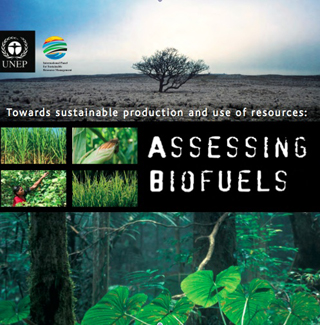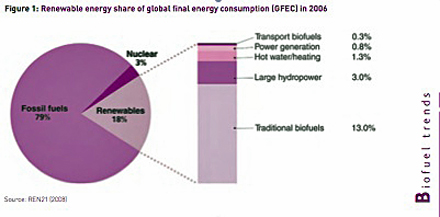Navigation
Assessing Biofuels Report Helps Give Greater Clarity to Burning Issue
The report, Towards Sustainable Production and Use of Resources: Assessing Biofuels, presented by the United Nations Environment Programme (UNEP) on 16 October 2009 is based on a detailed review of published research up to mid-2009 as well as the input of independent experts world-wide.
 |
| Assessing Biofuels concludes that a far more sophisticated approach needs to be taken when developing biofuels as an environmentally-friendly energy option. Cover of Report UNEP |
The report, Towards Sustainable Production and Use of Resources: Assessing Biofuels, presented by the United Nations Environment Programme (UNEP) on 16 October 2009 is based on a detailed review of published research up to mid-2009 as well as the input of independent experts world-wide. It was written to assist governments and industry in making sustainable choices in an area that over the past few years has become deeply divided while triggering sharply polarized views.
Assessing Biofuels concludes that a far more sophisticated approach needs to be taken when developing biofuels as an environmentally-friendly energy option.
Governments should fit biofuels into an overall energy, climate, land-use, water and agricultural strategy if their deployment is to benefit society, the economy and the environment as a whole.
The report, the first by UNEP’s International Panel for Sustainable Resource Management, says some first generation biofuels such as ethanol from sugar cane can have positive impacts in terms of greenhouse gas emissions.
As currently practiced in a country such as Brazil, it can lead to emissions reductions of between 70 percent and well over 100 percent when substituted for petrol.
However, the way in which biofuels are produced matters in determining whether they are leading to more or less greenhouse gas emissions. Conditions under which production of biofuels does lead to higher emissions have been identified in the report.
The production and use of biodiesel from palm oil on deforested peatlands in the tropics is cited. It can lead to significant increases in greenhouse gas emissions-up to 2,000 percent or more when compared with fossil fuels.
This is mainly as a result of carbon releases from the soils and land. However, a positive contribution to greenhouse gas emissions can arise if the palm oil or soya beans are instead grown on abandoned or degraded land.
Achim Steiner, UN Under-Secretary General and Executive Director of the UN Environment Programme, which hosts the Resource Panel, said : "Biofuels are neither a panacea nor a pariah but like all technologies they represent both opportunities and challenges."
"Therefore a more sophisticated debate is urgently needed which is what this first report by the Panel is intended to provide. On one level, it is a debate about which energy crops to grow and where and also about the way different countries and biofuel companies promote and manage the production and conversion of plant materials for energy purposes-some clearly are climate friendly while others are highly questionable," added Mr. Steiner.
"However, it is also a choice about how humanity best manages its finite land bank and balances a range of competing interests in a world of six billion people, rising to over nine billion by 2050," he said.
"The report makes it clear that biofuels have a future role, but also underlines that there may be other options for combating climate change, improving rural livelihoods and achieving sustainable development that may, or may not involve turning ever more crops and crop wastes into liquid fuels," he explained.
"The European Commission has been the firm supporter of the Resource Panel right from its outset. It is part of our long-term strategy on sustainable management of natural resources in providing authoritative and independent scientific advice to underpin policies and with a global perspective. The report on biofuels will help us in designing and implementing targets and sustainability criteria for the use of biofuels," said Timo Timo Mäkelä of the European Commission.
 The report by the Resource Panel, headed by Professor Ernst Ulrich von Weizsäcker and written by scientists including Dr Stefan Bringezu of the body's Biofuels Working Group, notes, for example, that: • Generating electricity at local power stations using wood, straw, seed oils and other crop or waste materials "is generally more energy efficient that converting biomass to liquid fuels". • Land, including abandoned land can be used for energy crops but could equally be used for re-afforestation or solar power which the report argues may be more efficient for turning sunlight into energy. •Meanwhile, in transport, modal shifts and higher fuel efficiency standards and the development of alternative technologies such as plug-in vehicles could dramatically reduce emissions in their own right. Photo UNEP The report points out that in the United States the Energy Independence Act requires fuel efficiency improvements of 40 percent for cars and light trucks by 2020. Similarly, Japan is set to adopt a 20 percent fuel efficiency improvement to be implemented by 2015 with car makers there claiming that 80 percent of vehicles already meet the proposed standard.
The report by the Resource Panel, headed by Professor Ernst Ulrich von Weizsäcker and written by scientists including Dr Stefan Bringezu of the body's Biofuels Working Group, notes, for example, that: • Generating electricity at local power stations using wood, straw, seed oils and other crop or waste materials "is generally more energy efficient that converting biomass to liquid fuels". • Land, including abandoned land can be used for energy crops but could equally be used for re-afforestation or solar power which the report argues may be more efficient for turning sunlight into energy. •Meanwhile, in transport, modal shifts and higher fuel efficiency standards and the development of alternative technologies such as plug-in vehicles could dramatically reduce emissions in their own right. Photo UNEP The report points out that in the United States the Energy Independence Act requires fuel efficiency improvements of 40 percent for cars and light trucks by 2020. Similarly, Japan is set to adopt a 20 percent fuel efficiency improvement to be implemented by 2015 with car makers there claiming that 80 percent of vehicles already meet the proposed standard.
Professor Weizsäcker said: "There are also wider life cycle issues that need to be factored into government policy decisions and in some cases these require more urgent research. Growing energy crops can involve increased use of fertilizers which in turn have implications for water quality. Fertilizer use also increases emissions of N20 which is a powerful greenhouse gas in its own right."
"Using abandoned or so called waste land for biofuels might be a sensible option, but it may also have implications for biodiversity and greenhouse gas emissions might be better cut by forestry schemes,' he added.
Dr. Bringezu said: "If the world's cropland is used to feed a growing population and one increasingly consuming meat, any additional demand for energy crops will almost inevitably increase pressure on grasslands, savannahs and forests. This will lead to more greenhouse gas emissions as well as rising losses of biodiversity. Using wastes and residues represents one safer and more sustainable path out of this dilemma."
 Biofuel Trends Chart UNEP
Biofuel Trends Chart UNEP
Key Findings From The Report:
Biofuel Market
World ethanol production for transport fuels tripled between 2000 and 2007 from 17 billion liters to more than 52 billion liters.
Biodiesel expanded 11 fold from less than a billion liters to 11 billion liters.
Biofuels provide 1.8 percent of transport fuels.
Investment in biofuels production capacity exceeded US$4 billion worldwide in 2007.
International trade has been small, about three billion liters in 2006/07, but is expected to grow rapidly in countries like Brazil where in 2008 five billion liters were exported.
Land-Use Changes and Related Impacts of First Generation Biofuels
Global cropland will expand only to feed a growing world population with an increasing demand for more protein rich food from animals. Any additional demand for non-food biomass crops will add to the pressure of converting natural land.
Global land use for biofuel crops was about two percent of global cropland in 2008, or about 36 million hectares.
First generation biofuels include, for example, ethanol from sugar cane or corn or biodiesel from rapeseed, soya or palm oil.
Globally about 118 to 508 million hectares of cropland would be needed to meet 10 percent of global transport fuel demand by 2030 if first generation biofuels are used. On the one hand, these biofuels could potentially substitute 0.17 to 0.76 billion tonnes of fossil CO2. On the other hand, the associated land-use change would lead to additional 0.75 to 1.83 billion tonnes of CO2.
Altogether, there could be rather more greenhouse gas emissions for the coming decades due to energy crop-based biofuels.
Land-use change for biofuel crops cannot be avoided by product standards and certification alone, as long as global demand for biomass is growing. Certified production would drive non-certified production, particularly for food, to other areas.
Climate Pros and Cons of Different Biofuels
Whether a biofuel is climate-friendly or contributes to climate change depends on numerous factors, basically whether it is based on crops or production residues and waste. The use of the latter is usually beneficial for the environment, requires no additional land and also provides economic benefits.
The growing and conversion processes from biomass to fuel determine the environmental performance.
Brazil's sugar cane-to-ethanol industry is considered to have a positive climate benefit because and in part it uses wastes known as bagasse to power the processing and to also generate electricity for the national grid.
Bioethanol from corn can be less climate-friendly in cases where fossil fuels are used in the process of converting the crop to liquid fuel. Depending on the efficiency of modern mills and other factors, it actually leads to a nearly 60 per cent cut in CO2 emissions when compared with gasoline, or a five percent increase in green house gas emissions.
Palm oil biodiesel can reduce emissions when compared to fossil fuels by 80 percent. But if the palm oil is grown on cropland from cleared tropical forests, greenhouse gas emissions can be up to 800 percent higher.
And if the land use was cleared peat forests the emissions increases over using fossil fuels can rise to 2,000 percent.
Examples of other beneficial biofuels are biomethane from manure, with emissions savings of over 170 percent and second generation ethanol produced from agricultural and forestry wastes savings in the region of 80 percent to 90 percent over petrol.
Jatropha, an energy crop being recommended in drylands in India and across Africa, can generate greenhouse gas savings if grown on degraded land but if grown on shrubland this can increase emissions through land use change. However, this needs to be balanced with the possibility to satisfy energy needs that are currently satisfied largely with traditional biomass use, which often leads to deforestation, again with an impact on climate change.
There are other impact categories beyond climate change that need to be assessed. The report highlights impacts on water quality and quantity and biodiversity.
The Way Forward
The report calls for governments to consider a variety of measures and for additional research including:
- Development of harmonized product standards for biofuels based on internationally-recognized life cycle-assessments, ones that factor in wider environmental aspects such as greenhouse gas emissions linked with fertilizers, impacts on water and implications for land use.
- Reconsideration of current biofuel mandates, targets and quota in order to limit the demand to levels which can sustainably be supplied - considering impacts for land use globally through targets for national use.
- Measures to limit the expansion of arable land into high-value natural ecosystems, such as forests and areas with high biodiversity. Brazil, for example, is developing a zoning system for palm oil production that distinguishes between suitable land and land of high conservation value.
- More comprehensive assessments of the amount of degraded land in the world that might be suitable for biofuel production set against its other potential uses such as for food production or forestry or natural regeneration, also considering the economic viability of biofuels produced on degraded land.
- Action to sustainably boosted yields in currently low-yielding countries and regions such as Africa so as to produce more crops per hectare of land for both food and energy use.
- Research into the environmental performance of advanced (often referred to as second and third) generation biofuels such as those derived from wastes and sources such as switch grass and marine algae.
- Research to compare the relative advantages in site specific locations of stationary power generation versus converting biomass into liquid fuels-assessments too of the relative merits of biofuels versus solar power on the same land.
- Introduce policies that reduce overall fuel consumption in countries such as through fuel taxes and fuel efficiency standards-for example, the European Union's Directive on energy end-use efficiency and energy services says every member state must improve its energy efficiency beyond the trend by one percent annually.
The objectives of the Resource Panel are to:
- Provide independent, coherent and authoritative scientific assessments of policy relevance on the sustainable use of natural resources and in particular their environmental impacts over the full life cycle.
- Contribute to a better understanding of how to decouple economic growth from environmental degradation.
Contact:
Nick Nuttall, UNEP Spokesperson/Head of Media
The contents of this article was provided by UNEP.
Search
Latest articles
Agriculture
- World Water Week: Healthy ecosystems essential to human health: from coronavirus to malnutrition Online session Wednesday 24 August 17:00-18:20
- World Water Week: Healthy ecosystems essential to human health: from coronavirus to malnutrition Online session Wednesday 24 August 17:00-18:20
Air Pollution
- "Water and Sanitation-Related Diseases and the Changing Environment: Challenges, Interventions, and Preventive Measures" Volume 2 Is Now Available
- Global Innovation Exchange Co-Created by Horizon International, USAID, Bill and Melinda Gates Foundation and Others
Biodiversity
- It is time for international mobilization against climate change
- World Water Week: Healthy ecosystems essential to human health: from coronavirus to malnutrition Online session Wednesday 24 August 17:00-18:20
Desertification
- World Water Week: Healthy ecosystems essential to human health: from coronavirus to malnutrition Online session Wednesday 24 August 17:00-18:20
- UN Food Systems Summit Receives Over 1,200 Ideas to Help Meet Sustainable Development Goals
Endangered Species
- Mangrove Action Project Collaborates to Restore and Preserve Mangrove Ecosystems
- Coral Research in Palau offers a “Glimmer of Hope”
Energy
- Global Innovation Exchange Co-Created by Horizon International, USAID, Bill and Melinda Gates Foundation and Others
- Wildlife Preservation in Southeast Nova Scotia
Exhibits
- Global Innovation Exchange Co-Created by Horizon International, USAID, Bill and Melinda Gates Foundation and Others
- Coral Reefs
Forests
- NASA Satellites Reveal Major Shifts in Global Freshwater Updated June 2020
- Global Innovation Exchange Co-Created by Horizon International, USAID, Bill and Melinda Gates Foundation and Others
Global Climate Change
- It is time for international mobilization against climate change
- It is time for international mobilization against climate change
Global Health
- World Water Week: Healthy ecosystems essential to human health: from coronavirus to malnutrition Online session Wednesday 24 August 17:00-18:20
- More than 400 schoolgirls, family and teachers rescued from Afghanistan by small coalition
Industry
- "Water and Sanitation-Related Diseases and the Changing Environment: Challenges, Interventions, and Preventive Measures" Volume 2 Is Now Available
- Global Innovation Exchange Co-Created by Horizon International, USAID, Bill and Melinda Gates Foundation and Others
Natural Disaster Relief
- STOP ATTACKS ON HEALTH CARE IN UKRAINE
- Global Innovation Exchange Co-Created by Horizon International, USAID, Bill and Melinda Gates Foundation and Others
News and Special Reports
- World Water Week: Healthy ecosystems essential to human health: from coronavirus to malnutrition Online session Wednesday 24 August 17:00-18:20
- STOP ATTACKS ON HEALTH CARE IN UKRAINE
Oceans, Coral Reefs
- World Water Week: Healthy ecosystems essential to human health: from coronavirus to malnutrition Online session Wednesday 24 August 17:00-18:20
- Mangrove Action Project Collaborates to Restore and Preserve Mangrove Ecosystems
Pollution
- Zakaria Ouedraogo of Burkina Faso Produces Film “Nzoue Fiyen: Water Not Drinkable”
- "Water and Sanitation-Related Diseases and the Changing Environment: Challenges, Interventions, and Preventive Measures" Volume 2 Is Now Available
Population
- "Water and Sanitation-Related Diseases and the Changing Environment: Challenges, Interventions, and Preventive Measures" Volume 2 Is Now Available
- "Water and Sanitation-Related Diseases and the Changing Environment: Challenges, Interventions, and Preventive Measures" Volume 2 Is Now Available
Public Health
- Honouring the visionary behind India’s sanitation revolution
- Honouring the visionary behind India’s sanitation revolution
Rivers
- World Water Week: Healthy ecosystems essential to human health: from coronavirus to malnutrition Online session Wednesday 24 August 17:00-18:20
- Mangrove Action Project Collaborates to Restore and Preserve Mangrove Ecosystems
Sanitation
- Honouring the visionary behind India’s sanitation revolution
- Honouring the visionary behind India’s sanitation revolution
Toxic Chemicals
- "Water and Sanitation-Related Diseases and the Changing Environment: Challenges, Interventions, and Preventive Measures" Volume 2 Is Now Available
- Actions to Prevent Polluted Drinking Water in the United States
Transportation
- "Water and Sanitation-Related Diseases and the Changing Environment: Challenges, Interventions, and Preventive Measures" Volume 2 Is Now Available
- Urbanization Provides Opportunities for Transition to a Green Economy, Says New Report
Waste Management
- Honouring the visionary behind India’s sanitation revolution
- Honouring the visionary behind India’s sanitation revolution
Water
- Honouring the visionary behind India’s sanitation revolution
- Honouring the visionary behind India’s sanitation revolution
Water and Sanitation
- Honouring the visionary behind India’s sanitation revolution
- Honouring the visionary behind India’s sanitation revolution

